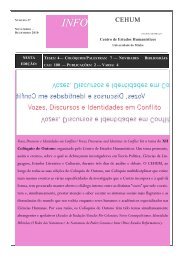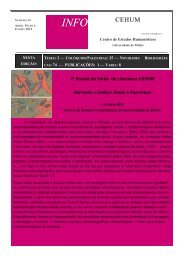Diacritica 25-2_Filosofia.indb - cehum - Universidade do Minho
Diacritica 25-2_Filosofia.indb - cehum - Universidade do Minho
Diacritica 25-2_Filosofia.indb - cehum - Universidade do Minho
Create successful ePaper yourself
Turn your PDF publications into a flip-book with our unique Google optimized e-Paper software.
QUEEN CAROLINE AND THE PRINT CULTURE OF REGENCY RADICALISM<br />
163<br />
with a literary quality, oft en undervalued. [4] Th e tone of sophisticated wit<br />
that defi nes the style of the BD is in agreement with the motto of the periodical<br />
– ‘Satire’s my weapon’. Th e Government, the representatives of State<br />
law, the King, and the Italian witnesses at the Queen’s trial were continued<br />
targets of Wooler’s vitriolic criticism. Th e BD [5] was a blend of serious political<br />
journalism, satire, and melodrama with a strong popular appeal.<br />
William Hone (1780-1842) was an autodidact parodist, publisher,<br />
bookseller, antiquarian and journalist, who in collaboration with George<br />
Cruikshank (1792-1878) authored some of the most widely circulated and<br />
infl uential satires printed between 1815 and 1822. [6] Until recently, Hone<br />
was a marginalized fi gure of early nineteenth-century English culture.<br />
Research by Marcus Wood (1994), Joss Marsh (1998), Kyle Grimes (1998a;<br />
2003; 2007), among others, has triggered interest in the authorial, antiquarian,<br />
and publishing work of William Hone, which Anne Bowden (1975)<br />
suggests may amount to about 228 titles, nearly ninety per cent of which in<br />
the period 1815-21.<br />
Th ese ‘voices from below’ (Th ompson, 1993) presented an innovative<br />
vision, discernible in the way the printed word and image were used as<br />
weapons against the established political and cultural authority.<br />
The Queen Caroline affair and the radical periodicals<br />
Taking into account the post-war radical agenda centred on the denunciation<br />
of political corruption and of the inequities of parliamentary representation,<br />
the Queen’s aff air remained an improbable focal point of radical<br />
contention. Th e question asked by the ‘Black Dwarf ’ to the ‘Yellow Bonze<br />
at Japan’: ‘Th ou wilt ask me what I have to <strong>do</strong> with those things? What the<br />
4 However, recent criticism challenges conventions about early nineteenth-century literature, by<br />
situating it in the larger context of ‘high’ and ‘low’ literature (Jones, 2003: 1-3).<br />
5 In the context of the social agitation of the year 1968, the New Left published, between 1968<br />
and 1972, a political and cultural newspaper, Th e Black Dwarf, which borrowed its name from<br />
Wooler’s periodical. To assert the continuity, the fi rst issue was numbered ‘Vol. 13 nº 1’. In 2008,<br />
the British painter John Hoyland, one of the members of the board of the Black Dwarf in 1968,<br />
wrote an article about this editorial experience in the Guardian 15 March 2008, to be viewed<br />
at: http://www.guardian.co.uk/music/2008/mar/15/popandrock.pressandpublishing. (accessed<br />
09/08/10).<br />
6 In his review of William Hone, Regency Radical: Selected Writings of William Hone, edited by<br />
Kent and Ewen (2002), Grimes (2007) considers Hone ‘perhaps the best-selling writer in England<br />
during the post-Peterloo and Queen Caroline aff air periods’. For Epstein (1994: 35), Hone<br />
was ‘the greatest radical satirist of the Regency era’.<br />
<strong>Diacritica</strong> <strong>25</strong>-2_<strong>Filosofia</strong>.<strong>indb</strong> 163 05-01-2012 09:38:27



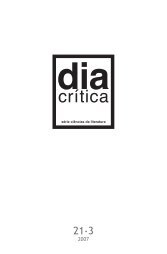

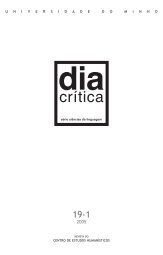



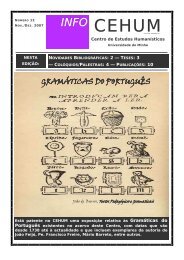

![Programa [pdf] - cehum - Universidade do Minho](https://img.yumpu.com/17305425/1/190x135/programa-pdf-cehum-universidade-do-minho.jpg?quality=85)


